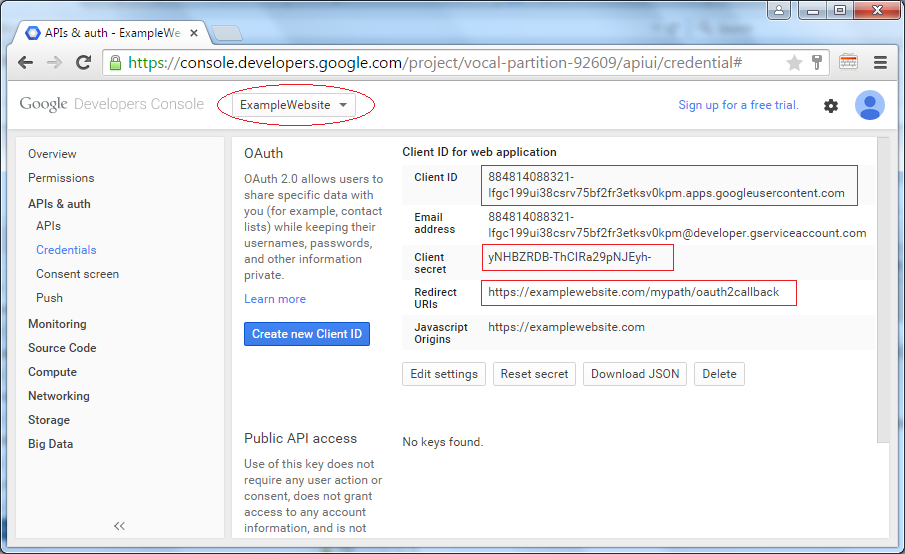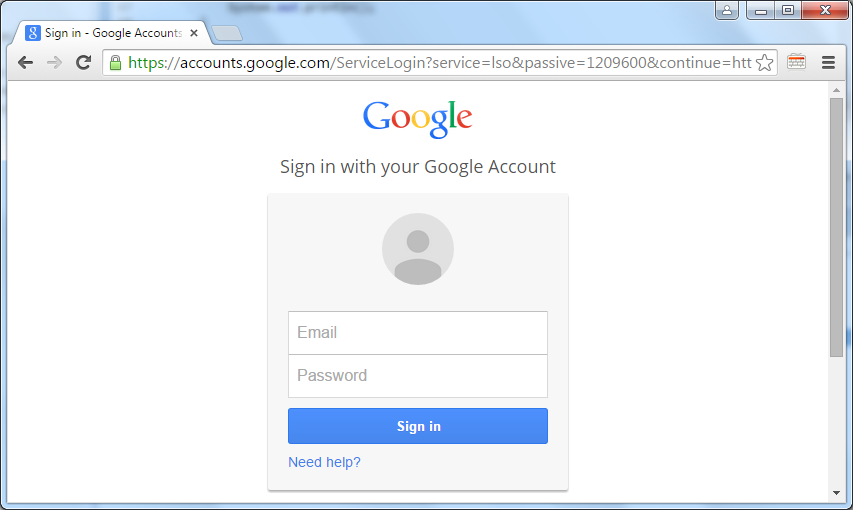Использование Scribe OAuth Java API с Google OAuth 2
1. Проблема с Google Oauth1a
Одна проблема с Google OAuth 1a. Начиная с 20-04-2015, google официально не поддерживает OAuth 1. Если вы используете Scribe Java API для работы с Google OAuth 1.0, то вам нужно поменять ваш код.
В данной статье я покажу как использовать Scribe Java API работая с Google OAuth 2.0
В данной статье я покажу как использовать Scribe Java API работая с Google OAuth 2.0
2. Создать приложение на Google Developers Console
In the first time, you do not have any Project, so you have to create it. In most cases, you should name Project same your Website name (It is not compulsory).

Project Name: ExampleWebsite

Project has been created:

Goto "APIs and auth/Consent screen", to create a Product Name.

Create Client ID:

In case you use OAuth2.0 on a web application, you will have to create ClientID for that web application. Parallel, you declare the redirecting link (The link will be redirected to after user logs in his/her google account and allows your application to connect with Google OAuth).

ClientID is created, in which the two most important kinds of information are Client ID and Client Secret. You need to have it in Java code (Illustrated in the following example).
Note: You can create multiple ClientIDinformation for your different applications.

3. Быстро создать Project & объявить библиотеку Scribe Java API
- File/New/Others



Ваш проэкт создан.

Конфигурация Maven используя Scribe Java API:
pom.xml
<project xmlns="http://maven.apache.org/POM/4.0.0"
xmlns:xsi="http://www.w3.org/2001/XMLSchema-instance"
xsi:schemaLocation="http://maven.apache.org/POM/4.0.0
http://maven.apache.org/xsd/maven-4.0.0.xsd">
<modelVersion>4.0.0</modelVersion>
<groupId>org.o7planning</groupId>
<artifactId>ScribeGoogleOAuth2</artifactId>
<version>0.0.1-SNAPSHOT</version>
<dependencies>
<!-- http://mvnrepository.com/artifact/org.scribe/scribe -->
<dependency>
<groupId>org.scribe</groupId>
<artifactId>scribe</artifactId>
<version>1.3.7</version>
</dependency>
</dependencies>
</project>4. Code Project
Scribe Java API это API позволяющий вам легко работать с OAuth, он скрывает разницу между поставщиками услуг OAuth (Google, yahoo, facebook,..), и поддерживает OAuth 1a, OAuth 2.0
Например, чтобы работать с LinkIn, ваш код:
OAuthService service = new ServiceBuilder()
.provider(LinkedInApi.class)
.apiKey(YOUR_API_KEY)
.apiSecret(YOUR_API_SECRET)
.build();Например, чтобы работать с Google OAuth 1a ваш код:
OAuthService service = new ServiceBuilder()
.provider(GoogleApi.class)
.apiKey(YOUR_API_KEY)
.apiSecret(YOUR_API_SECRET)
.build();Scribe Java API имеет API для разных поставщиков:
- FacebookApi
- GoogleApi
- FoursquareApi
- Foursquare2Api
- YahooApi
- TwitterApi
- ....
К сожалению, GooleApi используется только для Google OAuth 1, не для Google OAuth 2.0, и вы не найдете класс Google2Api в библиотеке Scribe 1.3.7 (Может из-за авторских прав).
Поэтому в вашем проэкте вам нужно создать класс Google2Api, и заметьте, он должен находиться в пакете org.scribe.builder.api:
Поэтому в вашем проэкте вам нужно создать класс Google2Api, и заметьте, он должен находиться в пакете org.scribe.builder.api:

Google2Api.java
package org.scribe.builder.api;
import java.util.regex.Matcher;
import java.util.regex.Pattern;
import org.scribe.exceptions.OAuthException;
import org.scribe.extractors.AccessTokenExtractor;
import org.scribe.model.OAuthConfig;
import org.scribe.model.OAuthConstants;
import org.scribe.model.OAuthRequest;
import org.scribe.model.Response;
import org.scribe.model.Token;
import org.scribe.model.Verb;
import org.scribe.model.Verifier;
import org.scribe.oauth.OAuth20ServiceImpl;
import org.scribe.oauth.OAuthService;
import org.scribe.utils.OAuthEncoder;
import org.scribe.utils.Preconditions;
/**
* Google OAuth2.0 Released under the same license as scribe (MIT License)
*
* @author yincrash
*
*/
public class Google2Api extends DefaultApi20 {
private static final String AUTHORIZE_URL = "https://accounts.google.com/o/oauth2/auth?response_type=code&client_id=%s&redirect_uri=%s";
private static final String SCOPED_AUTHORIZE_URL = AUTHORIZE_URL
+ "&scope=%s";
@Override
public String getAccessTokenEndpoint() {
return "https://accounts.google.com/o/oauth2/token";
}
@Override
public AccessTokenExtractor getAccessTokenExtractor() {
return new AccessTokenExtractor() {
@Override
public Token extract(String response) {
Preconditions
.checkEmptyString(response,
"Response body is incorrect. Can't extract a token from an empty string");
Matcher matcher = Pattern.compile(
"\"access_token\" : \"([^&\"]+)\"").matcher(response);
if (matcher.find()) {
String token = OAuthEncoder.decode(matcher.group(1));
return new Token(token, "", response);
} else {
throw new OAuthException(
"Response body is incorrect. Can't extract a token from this: '"
+ response + "'", null);
}
}
};
}
@Override
public String getAuthorizationUrl(OAuthConfig config) {
// Append scope if present
if (config.hasScope()) {
return String.format(SCOPED_AUTHORIZE_URL, config.getApiKey(),
OAuthEncoder.encode(config.getCallback()),
OAuthEncoder.encode(config.getScope()));
} else {
return String.format(AUTHORIZE_URL, config.getApiKey(),
OAuthEncoder.encode(config.getCallback()));
}
}
@Override
public Verb getAccessTokenVerb() {
return Verb.POST;
}
@Override
public OAuthService createService(OAuthConfig config) {
return new GoogleOAuth2Service(this, config);
}
private class GoogleOAuth2Service extends OAuth20ServiceImpl {
private static final String GRANT_TYPE_AUTHORIZATION_CODE = "authorization_code";
private static final String GRANT_TYPE = "grant_type";
private DefaultApi20 api;
private OAuthConfig config;
public GoogleOAuth2Service(DefaultApi20 api, OAuthConfig config) {
super(api, config);
this.api = api;
this.config = config;
}
@Override
public Token getAccessToken(Token requestToken, Verifier verifier) {
OAuthRequest request = new OAuthRequest(api.getAccessTokenVerb(),
api.getAccessTokenEndpoint());
switch (api.getAccessTokenVerb()) {
case POST:
request.addBodyParameter(OAuthConstants.CLIENT_ID,
config.getApiKey());
request.addBodyParameter(OAuthConstants.CLIENT_SECRET,
config.getApiSecret());
request.addBodyParameter(OAuthConstants.CODE,
verifier.getValue());
request.addBodyParameter(OAuthConstants.REDIRECT_URI,
config.getCallback());
request.addBodyParameter(GRANT_TYPE,
GRANT_TYPE_AUTHORIZATION_CODE);
break;
case GET:
default:
request.addQuerystringParameter(OAuthConstants.CLIENT_ID,
config.getApiKey());
request.addQuerystringParameter(OAuthConstants.CLIENT_SECRET,
config.getApiSecret());
request.addQuerystringParameter(OAuthConstants.CODE,
verifier.getValue());
request.addQuerystringParameter(OAuthConstants.REDIRECT_URI,
config.getCallback());
if (config.hasScope())
request.addQuerystringParameter(OAuthConstants.SCOPE,
config.getScope());
}
Response response = request.send();
return api.getAccessTokenExtractor().extract(response.getBody());
}
}
}Создайте класс MyConstants чтобы сохранить Google Client ID и Client Secret, которые вы создали до этого в Google Developers Console.
MyConstants.java
package org.o7planning.tutorial.scribegoogle;
public class MyConstants {
// Client ID
public static final String GOOGLE_CLIENT_ID = "884814088321-lfgc199ui38csrv75bf2fr3etksv0kpm.apps.googleusercontent.com";
// Client Secret
public static final String GOOGLE_CLIENT_SECRET = "yNHBZRDB-ThCIRa29pNJEyh-";
// Redirect URI
public static final String GOOGLE_REDIRECT_URL = "https://examplewebsite.com/mypath/oauth2callback";
}Google2Example.java
package org.o7planning.tutorial.scribegoogle.test;
import java.util.Scanner;
import org.o7planning.tutorial.scribegoogle.MyConstants;
import org.scribe.builder.ServiceBuilder;
import org.scribe.builder.api.Google2Api;
import org.scribe.model.OAuthRequest;
import org.scribe.model.Response;
import org.scribe.model.Token;
import org.scribe.model.Verb;
import org.scribe.model.Verifier;
import org.scribe.oauth.OAuthService;
public class Google2Example {
private static final String NETWORK_NAME = "Google";
private static final String PROTECTED_RESOURCE_URL = "https://www.googleapis.com/oauth2/v2/userinfo?alt=json";
private static final String SCOPE = "https://mail.google.com/ https://www.googleapis.com/auth/userinfo.email";
private static final Token EMPTY_TOKEN = null;
public static void main(String[] args) {
String apiKey = MyConstants.GOOGLE_CLIENT_ID;
String apiSecret = MyConstants.GOOGLE_CLIENT_SECRET;
String callbackUrl = MyConstants.GOOGLE_REDIRECT_URL;
// Create OAuthService for Google OAuth 2.0
OAuthService service = new ServiceBuilder().provider(Google2Api.class)
.apiKey(apiKey).apiSecret(apiSecret).callback(callbackUrl)
.scope(SCOPE).build();
Scanner in = new Scanner(System.in);
System.out.println("=== " + NETWORK_NAME + "'s OAuth Workflow ===");
System.out.println();
Verifier verifier = null;
Token accessToken = null;
// Obtain the Authorization URL
System.out.println("Fetching the Authorization URL...");
String authorizationUrl = service.getAuthorizationUrl(EMPTY_TOKEN);
System.out.println("Got the Authorization URL!");
System.out.println("Now go and authorize Scribe here:");
System.out.println();
// Copy this URL and run in browser.
System.out.println(authorizationUrl);
System.out.println();
// Copy Authorization Code in browser URL and paste to Console
System.out.println("And paste the authorization code here");
System.out.print(">>");
verifier = new Verifier(in.nextLine());
System.out.println();
// Trade the Request Token and Verfier for the Access Token
System.out.println("Trading the Request Token for an Access Token...");
accessToken = service.getAccessToken(EMPTY_TOKEN, verifier);
System.out.println("Got the Access Token!");
System.out.println("(if your curious it looks like this: "
+ accessToken + " )");
System.out.println();
// Now let's go and ask for a protected resource!
System.out.println("Now we're going to access a protected resource...");
OAuthRequest request = new OAuthRequest(Verb.GET,
PROTECTED_RESOURCE_URL);
service.signRequest(accessToken, request);
Response response = request.send();
System.out.println("Got it! Lets see what we found...");
System.out.println();
System.out.println(response.getCode());
System.out.println(response.getBody());
System.out.println();
System.out
.println("Thats it man! Go and build something awesome with Scribe! :)");
in.close();
}
}Запуск класса Google2Example:

Скопируйте URL как выделенно красным выше и запустите на браузере:

После, зайдите в ваш аккаунт google, Google требует User позволить иметь доступ к некоторым информациям аккаунта. Нажмите Accept для разрешения.

Website перенаправит (redirect) к Callback-URL, который включает доступ к коду и вам нужно скопировать этот код:

Скопируйте и вставьте в окно Java Console:

Вы получите информацию пользователя:

Java Open source libraries
- Руководство Java JSON Processing API (JSONP)
- Использование Scribe OAuth Java API с Google OAuth 2
- Получить информацию об оборудовании в приложении Java
- Restfb Java API для Facebook
- Создание Credentials для Google Drive API
- Руководство Java JDOM2
- Руководство Java XStream
- Использование Java JSoup для анализа кода HTML
- Получение географической информации на основе IP-адреса с помощью GeoIP2 Java API
- Чтение и запись файла Excel в Java с использованием Apache POI
- Изучите Facebook Graph API
- Манипулирование файлами и папками в Google Drive с использованием Java
Show More